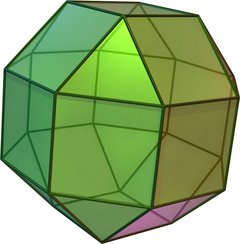Rhombicuboctahedron
|
|
| Rhombicuboctahedron | |
|---|---|
 Click on picture for large version. Click here for spinning version. | |
| Type | Archimedean |
| Faces | 8 triangles 18 squares |
| Edges | 48 |
| Vertices | 24 |
| Vertex configuration | 3,4,4,4 |
| Symmetry group | octahedral (Oh) |
| Dual polyhedron | deltoidal icositetrahedron |
| Properties | convex, semi-regular (vertex-uniform) |
The rhombicuboctahedron, or small rhombicuboctahedron, is an Archimedean solid with eight triangular and eighteen square faces. There are 24 identical vertices, with one triangle and three squares meeting at each. Note that six of the squares only share vertices with the triangles while the other twelve share an edge. The polyhedron has octahedral symmetry, like the cube and octahedron. Its dual is called the trapezoidal icositetrahedron, although its faces are not really true trapezoids.
Missing image
Rhombicuboctahedron_flat.png
image:Rhombicuboctahedron flat.png
The name rhombicuboctahedron refers the fact that 12 of the square faces lie in the same planes as the 12 faces of the rhombic dodecahedron which is dual to the cuboctahedron.
Canonical coordinates for a rhombicuboctahedron are (±(1+√2), ±1, ±1), (±1, ±(1+√2), ±1) and (±1, ±1, ±(1+√2)).
There are three pairs of parallel planes that each intersect the rhombicuboctahedron through eight edges in the form of a regular octagon. The rhombicuboctahedron may divided along any of these two obtain an octagonal prism with regular faces and two additional polyhedra called square cupolae, which count among the Johnson solids. These can be reassembled to give a new solid called the pseudorhombicuboctahedron (or gyroelongated square bicupola) with the symmetry of a square antiprism. In this the vertices are all locally the same as those of a rhombicuboctahedron, with one triangle and three squares meeting at each, but are not all identical with respect to the entire polyhedron, since some are closer to the symmetry axis than others.
There are distortions of the rhombicuboctahedron that, while some of the faces are not regular polygons, are still vertex-uniform. Some of these can be made by taking a cube or octahedron and cutting off the edges, then trimming the corners, so the resulting polyhedron has six square and twelve rectangular faces. These have octahedral symmetry and form a continuous series between the cube and the octahedron, analogous to the distortions of the rhombicosidodecahedron or the tetrahedral distortions of the cuboctahedron. However, the rhombicuboctahedron also has a second set of distortions with six rectangular and sixteen trapezoidal faces, which do not have octahedral symmetry but rather Th symmetry, so they are invariant under the same rotations as the tetrahedron but different reflections.
The lines along which a Rubik's Cube can be turned are, projected onto a sphere, similar, topologically identical, to a rhombicuboctahedron's edges.
Rhombicuboctahedra in the arts
The polyhedron in the portrait of Luca Pacioli is a glass rhombicuboctahedron half-filled with water.
See also
- cube
- cuboctahedron
- octahedron
- rhombicosidodecahedron
- truncated cuboctahedron (great rhombicuboctahedron)
- elongated square gyrobicupola
External links
- Archimedes and the Rhombicuboctahedron (http://agutie.homestead.com/files/rhombicubocta.html) by Antonio Gutierrez from Geometry Step by Step from the Land of the Incas.
- The Uniform Polyhedra (http://www.mathconsult.ch/showroom/unipoly/)
- Virtual Reality Polyhedra (http://www.georgehart.com/virtual-polyhedra/vp.html) The Encyclopedia of Polyhedranl:Romboėdrisch kuboctaėder
